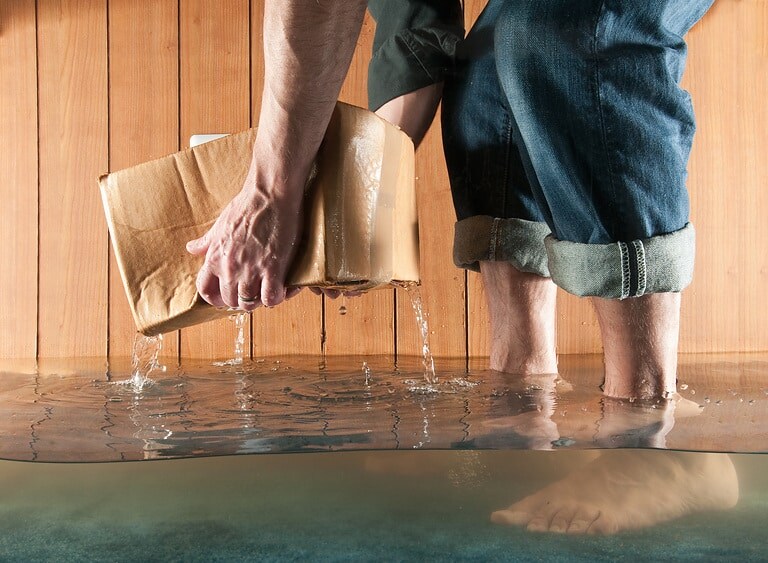02.05.2025
Basement flooded? Find out how to protect what matters to you.
A moment nobody wants to experience: you open the basement door, expecting dry tiles, but instead, the light reflects off the water. The smell is unfamiliar, panic sets in. Where does the water come from? How much damage has already occurred? And what needs to be done now? Whether it’s after a severe summer storm, an unexpected pipe burst, or a rising ground water level, a basement flood catches many homeowners completely off guard. What matters then is quick, thoughtful action — and a clear plan for the future. In this post, you’ll learn about the most common causes of basement flooding, how to respond effectively in an emergency, and what steps you can take to protect your home long-term.
Common causes of basement flooding
-
Heavy rainfall and overloaded sewer systems
Due to climate change, extreme weather with torrential rain is becoming more frequent. When the sewer system is overloaded, water cannot drain away and flows back into the house, especially into lower-level areas like the basement. -
Leaky or missing backflow protection
Without suitable lifting units or backflow valves in the home drainage system, wastewater can return to the pipes and eventually the basement during overload. -
Rising ground water
In areas with high ground water levels or after long periods of rain, water can seep through the ground and walls if they are not sealed effectively. -
Technical defects or pipe bursts
A burst water pipe or a faulty washing machine in the basement are classic triggers for unwanted water ingress.

First aid: What to do when your basement is flooded?
-
Stay calm and turn off power
Safety first! Enter the flooded area only after cutting off the power supply to avoid electric shocks. -
Pump out water quickly
The faster the water is removed, the less damage it causes. This is where our high-performance Wilo submersible pumps come into play. These compact and reliable helpers are perfect for emergency drainage. Not only are they easy to use but they also pump water down to a residual level of 2 mm. A secure power source, such as an elevated socket or a separate circuit, is required for commissioning. -
Vent and dry the basement thoroughly
After pumping out the water, vent, set up dryers, and draw as much moisture as possible from the masonry to prevent mould growth. -
Document damage and inform insurance
Take photos, record the water level, and contact your insurance company immediately to secure your claim for damage compensation.
Prevention tips to avoid basement flooding
A basement water damage incident is not only annoying but often costly. The good news: many causes can be prevented with the right measures in advance. Here are proven tips for prevention - for more safety around your home.
-
Install backflow protection
During heavy rain, the sewer system can be overloaded - without a functioning backflow protection, wastewater quickly returns to the house. A suitable lifting unit or backflow valve in the wastewater pipe ensures this doesn’t happen. This is especially important for rooms below the backflow level, such as basements. Regular maintenance of the backflow protection, ideally once a year, is essential. -
Keep drains and gutters clean
Leaves, dirt, and moss quickly clog gutters, downpipes, basement entrance drains, or light well drains. Water can’t flow properly, leading it to flowing along the house wall or even into the basement. Clean drains at least twice a year, especially before autumn and after winter. -
Seal basement chambers and light wells
Light wells are often weak spots where rainwater can enter. Special covers made of glass or polycarbonate protect against rain without hindering light entry. Additionally, check if the chambers are correctly drained - either by connecting to the house drainage or using a small submersible pump. -
Properly seal the basement
For older homes or in flood-prone areas, professionally sealing the basement walls is particularly important. Depending on the cause (pressing water, seepage water, condensation), various sealing techniques are used - inside and out. Consult a professional here, as even small leaks can cause significant long-term damage. -
Pump sump with submersible pump
A pump sump is a small pit in the basement floor that collects seepage water. With an appropriate Wilo submersible pump, this water can be automatically pumped out before it spreads in the room. Models with float switches start automatically when enough water accumulates - ideal for unoccupied or rarely used basement rooms. -
Keep emergency equipment ready
Even with the best preparation, extreme cases can still lead to water ingress. Save valuable time with this emergency equipment at hand:- Submersible pump
- Extension cable and power source outside the basement
- Watertight clothing and rubber boots
- Towels, buckets, wet vacuum
- Camera for documenting damage
- Sandbags to seal the basement entrance door if necessary
A Wilo submersible pump - your help in emergencies
When every minute counts, you must rely on technology. Our submersible pumps are robust, efficient, and easy to handle. They quickly pump out large amounts of water - whether in floods, pump sumps, or for draining ponds and pits. With integrated float switch, durable materials, and compact design, they are the ideal solution for homeowners who want to play it safe.

